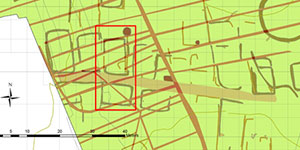During five weeks of work it is hoped to bring answers to a number of questions. Most important is it to decide the site's periods of use, in order to relate them to the core dates of the Gokstad mound - its construction in the decade around AD 900, and its defacement between AD 953 and c. AD 975. Other questions are the chronological relations between the burial area and the production and trading areas, the question about who the site was producing for and trading with, and whether it was a permanent or a seasonal site. Methodological issues are also addressed. By excavating structures that were partly revealed in 1995 we will investigate the long-term consequences of topsoil removal, and comparisons of excavated stratigraphy with that recorded in the geophysics will be made systematically.
Small fraction will be excavated
Only around 1 000 sqm, a very small fraction of the site, will be excavated, but due to the extraordinarily detailed mapping of the site by means of geophysics, coring, metal detecting and sieving of topsoil samples, it is hoped that it will be possible to target excavations exactly to those places which can provide answers to the research questions. The new, high-resolution GPR survey carried out in May this year forms a solid basis for this work, and can now be combined with distribution maps of coins, ingots, weights, metal casting and iron working waste, glass, peals, amber, burned bone etc.. It already appears that the trading and production area was divided into functionally distinct areas, and that the site had more phases, with some overlapping structures.

Cumbersome digging
During the first week of excavations, we have opened a 300 sqm large trench encompassing two lots on either side of the "street", in an area which has produced signs of working of both iron and other metals, and of trade. Since part of this area was opened in 1995, the conservation issues will be part of the agenda for this dig, along with the dating issues and the question about permanence versus seasonality. Digging in this area is cumbersome, since the topsoil here consists of heavy clay. The topsoil is removed by machine in thin layers, with systematical use of metal detecting. On contact with archaeological layers, manual excavation techniques and single context methodology is applied. So far it appears that the old surface has fallen prey to modern agriculture, and that archaeological layers are only preserved in trenches and depressions.
1,000 finds in 2012
Parallel with the excavation, sieving of systematic samples and metal detecting is continued over the entire site, in order to expand and improve the distribution maps of the site. So far, about 1,000 finds have been registered in 2012, not including materials like iron slags, burned bone and burned clay. Most of these finds originates from the metal detecting work, which is mainly carried out by volunteers from Norway's Metal Detecting Association. The project is greatly in debt to these for their enthusiasm and engagement.
